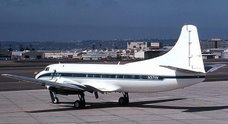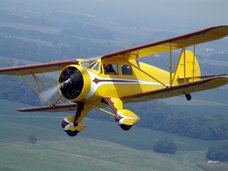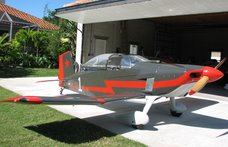AKA: Stupid Hatz Tricks 
by Jeff Cain and Vince Hahn
Question: How high can you legally fly a homebuilt open cockpit biplane without a transponder or oxygen?
.
Flying 'Eve,' our homebuilt Hatz biplane up and over the Continental Divide sounded like fun. Why not? A cool June morning (45 degrees on the ground) would give us thicker air and the wind was forecast to be over the mountains from the West at only 20mph.
.
The Hatz is a popular plans-built biplane with a steel tube fuselage, wooden spars, ribs and covered in fabric. Our Hatz, (NX8032Y and serial number 6) was built in 1981 by Ray and Dorothy Hill of Baxter Iowa and was only the second to be built from the then new plans. Eve’s 160-hp Lycoming 0-320 engine and a wooden Sensenich propeller makes her the perfect airplane to hop rides for kids (400 so far): slow cruise and good climb. But how would she do in the mountains? Before heading over the Rocky Mountains, we consulted with EAA Flight Advisor Bill Mitchell, our instructor and flying mentor, to review the route and mountain flying tips.
.
At 8:15 that morning the wheels cleared the runway outside of Denver and we headed west, climbing well over Boulder’s scenic foothills into clear skies and smooth air. But not for long.
.
By 9000 feet and only half way to the summit, despite our cruise climb rate of 500 fpm, the air quickly became “a bit” bumpy, as the combination of early thermals, westerly winds and rising mountains tossed us up—1500 fpm--and down at 500 fpm. Using ridge lift and Bill’s carefully chosen approach to the divide over a flat plateau; we were finally able to break into smoother air above 11,000 feet.
.
A good thing, because as we crossed the Continental Divide westward at 12,000 feet, the snow covered ridge loomed up at us at 11,000 feet. The tour over the Winter Park ski area was cut short, clouds were already beginning to extend along the divide. The top of nearby Mt. Evans to our south (14,264 feet) was covered with cloud and neither of us wanted to spend the night on the other side of the Rockies trapped by weather. Crossing back eastward, the upslope wind along Mt. Evans’ flanks helped us top out at 13,500 feet, where it was cold enough for our breath to freeze on the open cockpit windscreens.
.
Heading back down the hill riding smooth currents brought smiles, laughs, and warmth. Fingers and toes thawed out by the time we reached the grass runway at Colorado Antique Field (over the pass the temp was only 15 degrees F---plus wind chill) where we were able to warm up and share stories and lies with our Antique Aircraft Association friends.
.
The Answer:
Aircraft must have a transponder for flights above 10,000 feet MSL, excluding the airspace at or below 2500 feet AGL (FAR 91.215). Oxygen is required for crewmembers o n flights at cabin pressure above 14,000 feet or for flights longer than 30 minutes between 12,500 and 14,000 feet (FAR 91.211). With an open cockpit, cabin pressures and temperatures are of course the same as outside temperature and pressures.
n flights at cabin pressure above 14,000 feet or for flights longer than 30 minutes between 12,500 and 14,000 feet (FAR 91.211). With an open cockpit, cabin pressures and temperatures are of course the same as outside temperature and pressures.
.
Yes, we were legal.
It was a complete gas.
And an altitude record for Hatz biplanes.

by Jeff Cain and Vince Hahn
Question: How high can you legally fly a homebuilt open cockpit biplane without a transponder or oxygen?
.
Flying 'Eve,' our homebuilt Hatz biplane up and over the Continental Divide sounded like fun. Why not? A cool June morning (45 degrees on the ground) would give us thicker air and the wind was forecast to be over the mountains from the West at only 20mph.
.
The Hatz is a popular plans-built biplane with a steel tube fuselage, wooden spars, ribs and covered in fabric. Our Hatz, (NX8032Y and serial number 6) was built in 1981 by Ray and Dorothy Hill of Baxter Iowa and was only the second to be built from the then new plans. Eve’s 160-hp Lycoming 0-320 engine and a wooden Sensenich propeller makes her the perfect airplane to hop rides for kids (400 so far): slow cruise and good climb. But how would she do in the mountains? Before heading over the Rocky Mountains, we consulted with EAA Flight Advisor Bill Mitchell, our instructor and flying mentor, to review the route and mountain flying tips.
.
At 8:15 that morning the wheels cleared the runway outside of Denver and we headed west, climbing well over Boulder’s scenic foothills into clear skies and smooth air. But not for long.
.
By 9000 feet and only half way to the summit, despite our cruise climb rate of 500 fpm, the air quickly became “a bit” bumpy, as the combination of early thermals, westerly winds and rising mountains tossed us up—1500 fpm--and down at 500 fpm. Using ridge lift and Bill’s carefully chosen approach to the divide over a flat plateau; we were finally able to break into smoother air above 11,000 feet.
.
A good thing, because as we crossed the Continental Divide westward at 12,000 feet, the snow covered ridge loomed up at us at 11,000 feet. The tour over the Winter Park ski area was cut short, clouds were already beginning to extend along the divide. The top of nearby Mt. Evans to our south (14,264 feet) was covered with cloud and neither of us wanted to spend the night on the other side of the Rockies trapped by weather. Crossing back eastward, the upslope wind along Mt. Evans’ flanks helped us top out at 13,500 feet, where it was cold enough for our breath to freeze on the open cockpit windscreens.
.
Heading back down the hill riding smooth currents brought smiles, laughs, and warmth. Fingers and toes thawed out by the time we reached the grass runway at Colorado Antique Field (over the pass the temp was only 15 degrees F---plus wind chill) where we were able to warm up and share stories and lies with our Antique Aircraft Association friends.
.
The Answer:
Aircraft must have a transponder for flights above 10,000 feet MSL, excluding the airspace at or below 2500 feet AGL (FAR 91.215). Oxygen is required for crewmembers o
 n flights at cabin pressure above 14,000 feet or for flights longer than 30 minutes between 12,500 and 14,000 feet (FAR 91.211). With an open cockpit, cabin pressures and temperatures are of course the same as outside temperature and pressures.
n flights at cabin pressure above 14,000 feet or for flights longer than 30 minutes between 12,500 and 14,000 feet (FAR 91.211). With an open cockpit, cabin pressures and temperatures are of course the same as outside temperature and pressures..
Yes, we were legal.
It was a complete gas.
And an altitude record for Hatz biplanes.
Thanks, Ray and Dorothy (pictured above right with the author and the Hatz at Blakesburg Iowa's Antique Airfield, 2005).



No comments:
Post a Comment